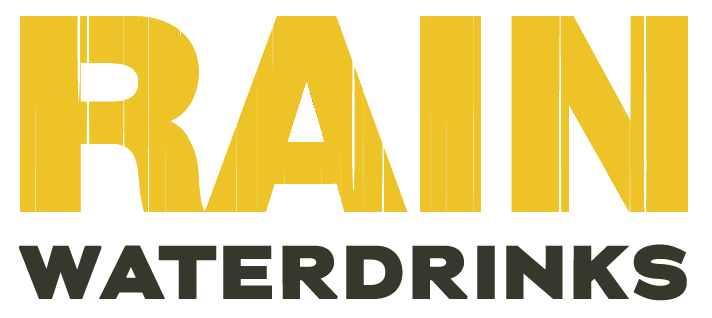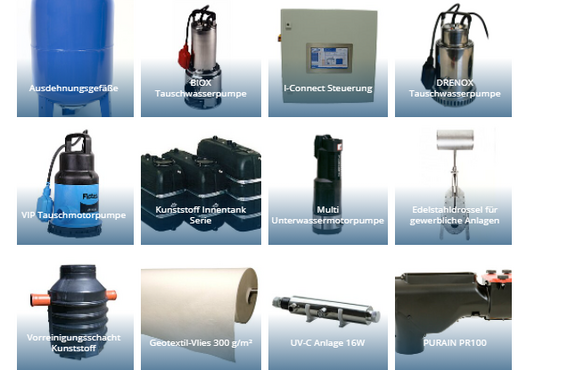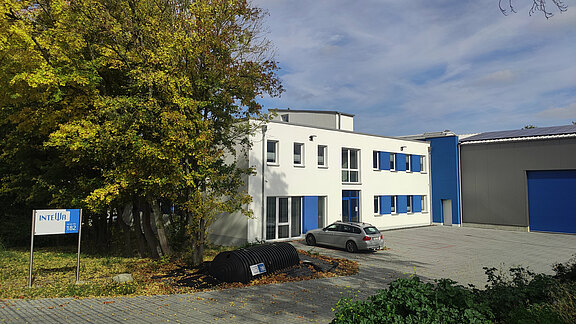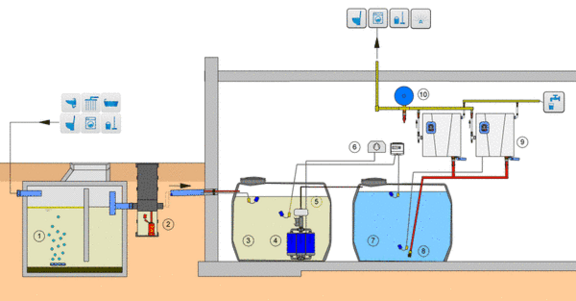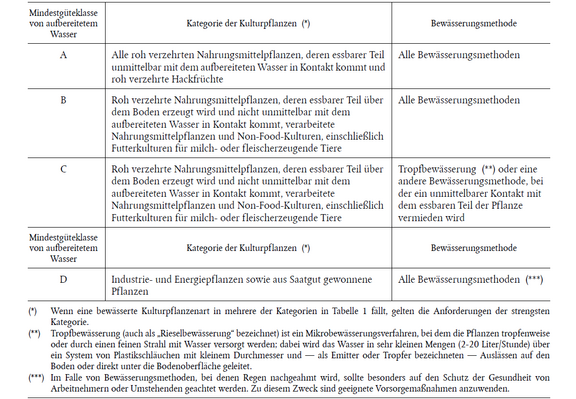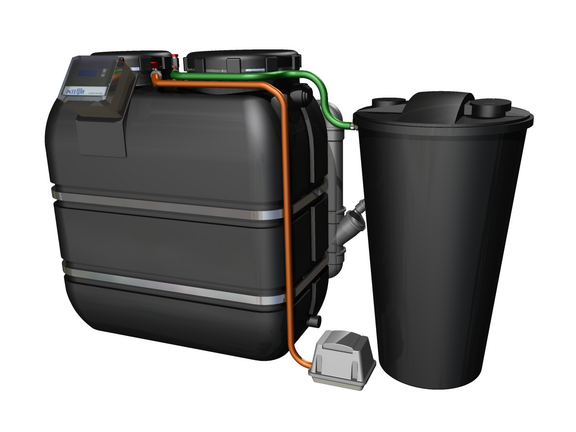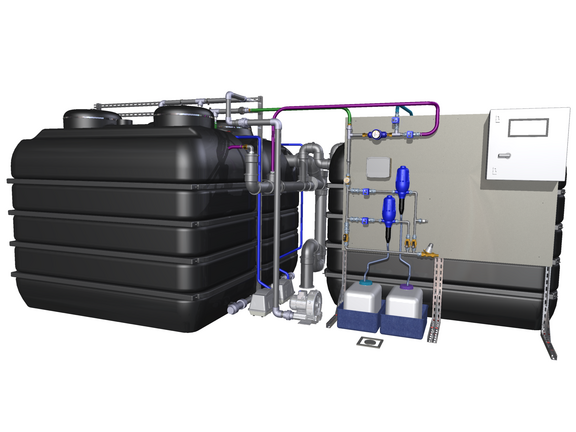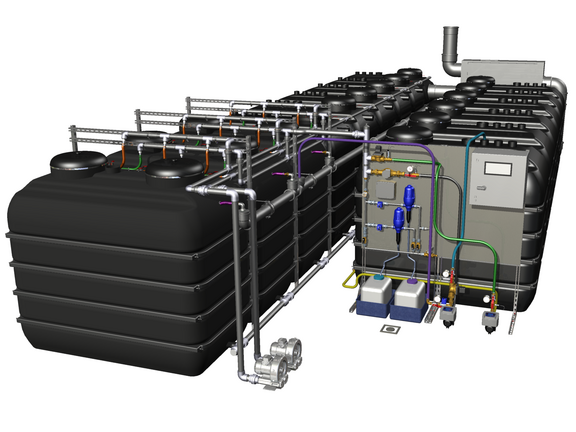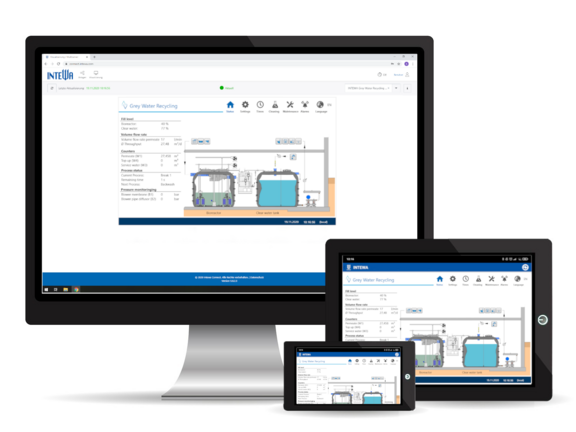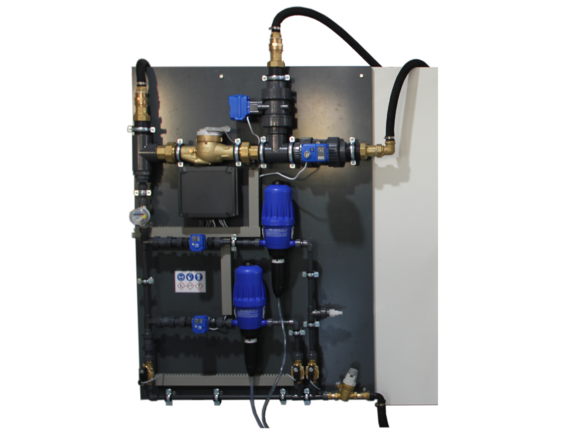Reuse of service water from small sewage treatment plants for agricultural irrigation
In the context of EU Regulation 2020/741 on minimum requirements for water reuse
With the new Regulation 2020/ 741 on minimum requirements for water reuse of May 25, 2020, the European Parliament has ushered in a new era for the reuse of wastewater, mainly for agricultural use:
“(1) Water resources in the Union are under increasing pressure, leading to water scarcity and deterioration of water quality. In particular, climate change, unpredictable weather patterns and droughts contribute significantly to increasing pressure on freshwater resources caused by urban development and agriculture.”
In addition to agricultural forms of use, other forms of use are also explicitly suggested:
“(29) The treatment and reuse of treated waste water offers great potential. In order to support and encourage the use of water reuse, the indication of specific uses under this Regulation should not prevent Member States from allowing the use of reclaimed water for other purposes, including industrial, recreational and environmental purposes, where deemed necessary in the light of national circumstances and requirements, provided that a high level of protection of the environment and of human and animal health is ensured.”
While the agricultural use of this new water source is of great interest in many countries, the water consumption of greenery to minimize urban heat islands is becoming increasingly important. This is particularly important when it comes to water, as more and more buildings are integrating green roofs, façades or plants. Where should the water for irrigation come from, especially as it is becoming increasingly scarce due to climatic conditions? It is particularly interesting that when treated wastewater is used for irrigation purposes, the treatment technology can also be retrofitted, as no separate service water pipe system needs to be laid in the building. However, the use of wastewater as service water for flushing toilets or as washing water, for example, is already being implemented in initial projects. A building that produces wastewater should be considered as a whole complex and thus subjected to a holistic and sustainable transformation.
If the wastewater is obtained from central (usually municipal) sewage treatment plants, it must be checked whether the transportation costs of the treated water to the extraction points can be justified.
With the AQUALOOP water treatment series, INTEWA has now developed a complete range of ready-to-connect systems from 300 - approx. 50,000 l/day and multiples thereof.
The Aachen-based company has perfected the technology over the last 10 years and has already successfully implemented it in over 100 projects worldwide (in the field of greywater recycling).
How does a small sewage treatment plant effluent recycling system work?
The systems can be used if a small sewage treatment plant already exists. The INTEWA systems are installed downstream of an existing small sewage treatment plant and treat the wastewater from this treatment plant (1).
The small sewage treatment plant effluent that has been pre-cleaned with a standard sewage treatment plant is usually pumped into the AQUALOOP bioreactor (3) via a submersible motor pump (2). If the AQUALOOP system is installed in the basement of a building, the drain water can also be discharged directly down a geodetic gradient. As a rule, however, the small sewage treatment plants are installed outside the building. If frost-proof operation is possible, the AQUALOOP system can also simply be installed outside the building. The dirt collected in the pre-filter is regularly flushed back into the sewer using a backwash nozzle if it is still connected.
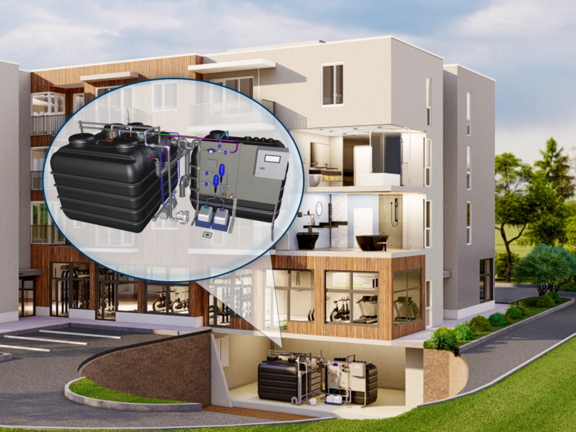
In the bioreactor, further continuous biodegradation takes place using bacteria. The use of an additional bioreactor has proven to be necessary in practice, as the effluent water from most sewage treatment plants is not always sufficiently degraded for the downstream ultrafiltration process, despite the biological stage and even with very good effluent values. A so-called direct filtration process is possible, but would lead to greater maintenance costs for membrane cleaning (4). The bacteria that are to take over the further degradation process are supplied with oxygen via a blower (6) through a tube diffuser located at the bottom of the system. The bacteria settle on the many hundreds of growth bodies, which are special floating bodies with a large surface area. A sludge pump, also located at the bottom, periodically removes any sediment. The bioreactor also contains the membrane stations (5), which filter the small sewage treatment plant effluent into the clear water storage tank (7) using ultrafiltration.
Due to the small membrane pore size of 0.02 µm, particles, bacteria and even viruses are retained. The membranes are periodically cleaned by backwashing and coarse air bubbles. Systems > 5,400 l/day treatment volume are equipped with a browser-compatible control system (I-CONNECT) and automatic chemical cleaning technology. This enables even more economical and low-maintenance operation, especially for the larger systems. Smaller systems, on the other hand, are equipped with the triple membrane surface in order to minimize the required maintenance intervals. The clean, hygienically treated process water is then pumped to the consumers by booster systems (9) and used for irrigation (as process water if necessary). To achieve the highest possible level of safety, the already ultra-filtered process water undergoes UV treatment as a final stage.
Where are small sewage treatment plant effluent recycling systems particularly suitable?
Ideally, these systems can be used wherever there is already a sewage treatment plant with appropriate effluent qualities. With decentralized small sewage treatment plants, transport routes for the water can be saved. If the water is used outside the building, the existing systems can be retrofitted. In areas without frost, outdoor installation is possible. The ideal areas of application are, for example, farms with a corresponding irrigation requirement or buildings with a greening and cooling requirement.
A major advantage of small sewage treatment plant drainage water recycling systems over rainwater harvesting systems is that they are independent of roof surfaces and precipitation conditions, so they are not subject to major fluctuations over the course of a year and ultimately only require small storage volumes. Compared to greywater recycling systems, the systems supply at least twice as much water, as the washing machine, kitchen and black water is also fed in completely. In Germany, this results in around 120 liters of wastewater per person per day. In many other countries, this can be up to 250 l/person/day.
Particular attention must be paid to the effluent water quality of the upstream small sewage treatment plant, as otherwise increased maintenance costs can be expected. According to the minimum requirements of the North Rhine-Westphalia Wastewater Ordinance (size class 1 according to Annex 1, Part C), the effluent values of small sewage treatment plants must not exceed 150 mg/l COD and 40 mg/l BOD5 . These discharge values must not be exceeded.
If there is no longer enough water available for irrigation, it almost goes without saying that the run-off water from a sewage treatment plant can be reused. In addition, the costs for drinking water are also saved, which are so high in some areas that such systems can even pay for themselves. An amortization within can be shown for water prices from 3.00 /m³ approx. When used as irrigation water, the waste water costs cannot be included in the calculation or charged by the disposal company, as this water is no longer discharged into the sewer. If both the drinking water and wastewater charges can be saved, as is often the case when the water is used as service water within a building, the double use also results in a double financial gain: Both drinking water and wastewater charges are saved. In many countries, the combined drinking water and wastewater costs are already over € 6.00/m³. Depending on the price of water and the size of the system, payback periods of less than 6 years can now be achieved.
Increase in the value of the building
The integration of a small sewage treatment plant can achieve a higher classification for building certification (e.g. DGNB, LEED, BREEAM, etc.). This can lead to financing advantages due to the EU taxonomy and sustainability classification.
Achieving sustainable building standards
With a small sewage treatment plant drainage water recycling system, building owners and planners make a significant contribution to achieving the sustainability goals of the United Nations by saving water and wastewater.
Low space requirement
Small sewage treatment plant effluent recycling systems are extremely space-saving, as the water is produced daily and can be reused directly. This eliminates the need for larger storage capacities, which is a clear advantage over other systems. One cubic meter of water for daily use can be stored in an area of one square meter.
Water quality, possible uses and monitoring?
Thanks to the special treatment process with a membrane bioreactor, which includes both biodegradation and ultrafiltration with a pore size of 0.02 µm, the systems deliver outstanding water quality that meets the highest standards. Compared to other processes, even germs and viruses are safely retained. The INTEWA systems are the first and so far only systems in the world to be certified according to the important NSF "Class C" standard for greywater. The systems have also been certified to the British Standard (greywater recycling) for spray irrigation. No certification has yet been obtained for the treatment of waste water from small sewage treatment plants. However, the achievable effluent qualities are fulfilled by the processes: Secondary treatment + filtration + disinfection meet quality class A according to Regulation (EU) 2020/741.
According to the regulation, the operators of the treatment facilities carry out routine monitoring to check whether the treated water meets the minimum water quality requirements. Routine monitoring is part of the water reuse system control procedures. The samples used to verify compliance with the microbiological parameters at the point of compliance shall be taken in accordance with standard EN ISO 19458 or other national or international standards ensuring equivalent quality.
If the highest quality class A is achieved, the treated water can be used with all irrigation methods and for the irrigation of all food crops and root crops whose edible part comes into direct contact with the treated water.
Dimensioning, planning and installation
The dimensioning of a small sewage treatment plant effluent recycling system is based on the daily requirement and daily yield. INTEWA now offers a range of prefabricated systems from 300 to 48,600 liters of treatment volume per day:
The AL-GW300 to AL-GW3600 systems are equipped with an AQUALOOP control unit.
The larger systems AL-GW5400 to AL-GW21.600 have a remote control with I-CONNECT and automatic cleaning I-CON-ADS.
In addition to I-CONNECT and I-CON-ADS, the AL-GW32400 to AL-GW48600 systems also have a central filtration and backwash pump.
Even larger systems are combined. The prefabricated systems can be planned very quickly and safely and enable uncomplicated installation, which can be carried out quickly by any installer.
Operation and maintenance with I-CONNECT
The I-CONNECT controller is the heart of the system and, with the appropriate accessories, enables remote monitoring and remote control of small sewage treatment plant effluent recycling systems with a capacity of over 5,400 l/day. The respective system can be accessed online via a web portal or an app.
The Viewer license allows you to view the systems, while the Expert license enables online configurations directly on the system. Depending on the version, the control units can be operated offline via a touch display or computer. The data is hosted on secure servers in Europe. The controller allows output to common building management systems such as Bacnet.
Automatic dry cleaning
Systems > 5,400 l/day are equipped with the so-called I-CON-ADS technology. This enables the automatic chemical cleaning of the membrane cartridges. The average volume flow of the ultrafiltration membranes can thus be tripled and the efficiency of the filtration process increased. The comprehensive cleaning process consists of acidic cleaning with citric acid, which dissolves inorganic compounds (scaling) in the membrane and pipes. This is supplemented by oxidative cleaning with chlorine to remove organic blockages.
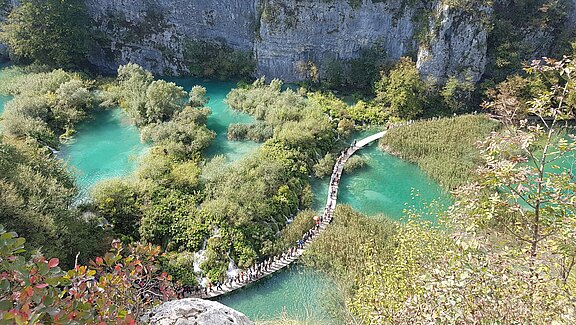
References
Plitvice Lakes National Park, Croatia
Three new guesthouses for seasonal workers were built very close to this water-rich tourist magnet in 2022. Due to the remote region, all guesthouses are equipped with their own small sewage treatment plant. In order to save valuable drinking water, the wastewater from these treatment plants was additionally treated with AQUALOOP technology so that it can now be reused for irrigation or seeped away without hesitation.
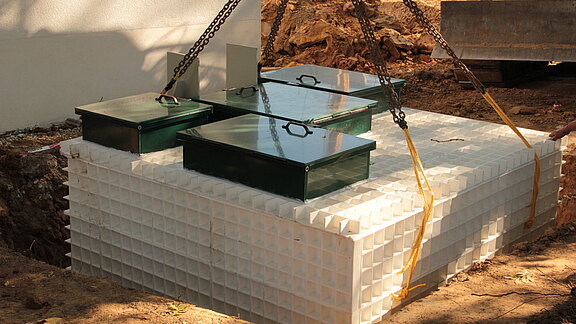
INTEWA Headquarters Aachen
Using AQUALOOP technology (including UV disinfection and ultrafiltration), the wastewater from the fully biological CFP compact sewage treatment plant from the Schachtprofi brand (Constant Flow Processing) at INTEWA's headquarters is further treated to process water quality and then used in a separate pipe circuit with a RAINMASTER Eco to flush the toilets. This circulation process saves both drinking water and wastewater costs. In the case of small sewage treatment plants without a drain, the costs for extracting the water are also saved. A water yield of approx. 100 m³/year from hand basins, toilets, sinks, dishwashers, cleaning water and floor drains is offset by a water requirement of approx. 66 m³/year for toilet flushing. Additional water will also be used in future for the growing greenery.
Summary and outlook
The enormous significance and the high future-oriented potential of sewage treatment plant effluent for further use, particularly in agricultural irrigation, but also for inner-city irrigation of greenery and for the use of process water, have now been scientifically recognized. EU Regulation 2020/741 has created a valuable basis for implementation in practice. With a new series of ready-to-connect systems, the water expert INTEWA from Aachen shows that this form of water reuse has now reached the highest technological level for irrigation and is even well suited for retrofitting. The systems feature automatic cleaning, browser-based control and remote maintenance and can therefore be operated conveniently and easily online from anywhere in the world. This reduces maintenance costs and guarantees functional reliability and the resulting certified quality of the treated water, which meets the highest standards.
Author: Oliver Ringelstein, INTEWA GmbH
Characters: 15,517 incl. spaces
Further information:

